The best ways to prolong the flowering of petunias in pots: advice from experienced gardeners
If the rose is considered the queen of the garden, then petunia can rightfully be called the queen of city flower beds. In almost extreme conditions of sunshine, dust and often drought, it manages not only to grow, but also to bloom magnificently and colorfully. And in the garden, with careful care, it pleases from spring until almost frost.
However, even such an unpretentious plant could use some attention and care. And if you bring it indoors during the autumn cold spell, it will continue to bloom until the new year. What needs to be done and how to prolong the flowering of petunias in pots, read on.
When and for how long does petunia bloom?
Petunia has very small, microscopic seeds. It is irrational and difficult to sow it directly into open ground. further care. Therefore, this flower is grown through seedlings. Seeds They are sown in March, and already in early May the seedlings are transplanted into flower beds. Moreover, most of the seedlings already have flowers. Petunia blooms profusely and luxuriantly, despite the heat, wind, and lack of moisture. Flowering continues until frost and stops only because the plants simply die from frost.
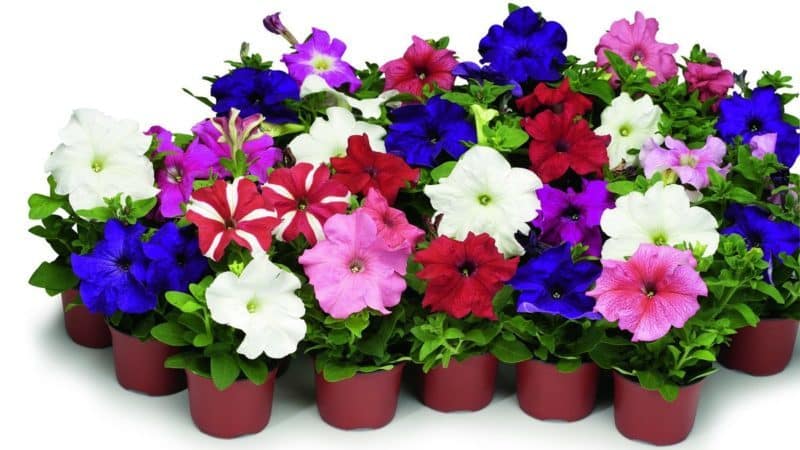
How to properly care for petunia during the flowering period
Even such a hardy plant requires care. The steps are simple, and if you follow them, there will be a lot of flowers. Let's see what petunias need for healthy and lush flowering.
Spacious potty
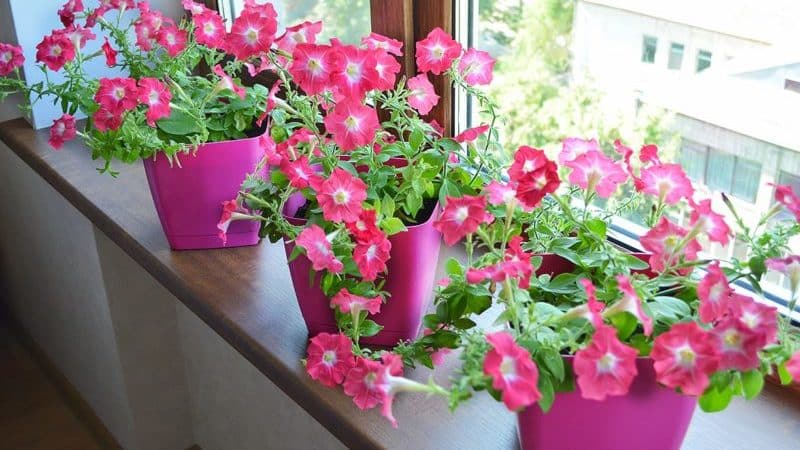
Petunia has a powerful root system with many small roots, so when planting it in a flowerbed it should not be thickened. When thickened, the bushes will suppress each other, and this will certainly affect flowering - there will be fewer flowers and they will grow small. For balcony plants, you need to choose containers in which the roots will not be crowded. As a rule, this is at least 3 liters, and preferably 5 liters per sprout. No more than three sprouts are planted in large balcony boxes with a volume of 10 liters.
Reference. Large cascading and ampelous petunia varieties require even more space. Such plants are planted one at a time in a 10 liter container.
Some gardeners are of the opinion that this is not necessary, and a 1-2 liter container is quite enough for petunia. If you have little space and want to decorate your balcony, try doing it this way. But in this case, provide the flowers with abundant and frequent feeding. However, even with this, be prepared for less lush flowering.
High quality soil
Like all crops of the Solanaceae family, petunia greatly depletes the soil, taking many useful substances from it. Therefore, it requires rich and fatty soil. In fertile soil, roots develop quickly and well, the plant becomes strong and produces many large and beautiful flowers. In addition, the soil should be loose and breathable, not compacted by frequent watering, allow excess water to pass through well and still remain moist.
The soil for petunia is made up of garden soil, peat and humus in a ratio of 3:2:1. Add a little wood ash, which serves as a potassium fertilizer and improves the quality and brightness of flowering.
Proper watering
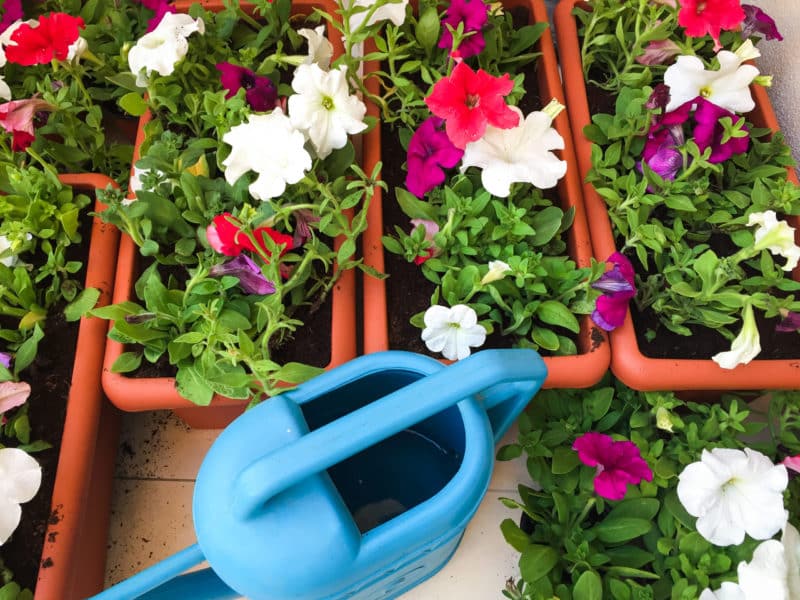
Despite its drought resistance, petunia still needs regular and abundant watering, especially in hot weather. With a lack of moisture, the shoots wither and weaken, the flowers fall off, and new ones are not formed. Therefore, petunia should be watered every day as the soil dries out. Usually this is 1-2 times a day. Flowers on balconies and under a canopy do not receive natural rainfall, unlike those planted in a flower bed, so their condition must be monitored especially carefully and watered abundantly. To do this, use clean, settled water at room temperature.
Overmoistening and stagnant water are even more harmful to petunias than drought. The roots quickly rot, the plants begin to hurt and may die. Therefore, when planting, it is important to ensure that the containers have large drainage holes and add a layer of pebbles, expanded clay, broken bricks or other drainage.
Attention! Petunia is watered only at the root. Unlike most flower crops, sprinkling does not benefit either the flowers or the greenery.
Ideal conditions
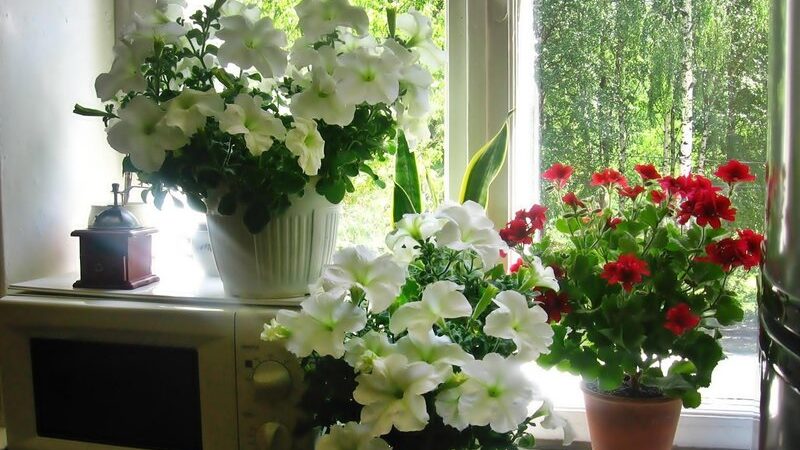
Petunia loves the sun. This is the first and indispensable condition for obtaining beautiful flowers. In shading, the plants will be more modest and will not grow to their full potential. The culture is very hardy, so it feels great even in the sun. Don’t be afraid to put it in the brightest place on the balcony or plant it in a flowerbed exposed to direct sunlight from morning to evening - this will only benefit it.
Petunia is unpretentious in relation to its neighbors; it grows well next to many crops. The combination is excellent with geranium, marigold, snapdragon, ageratum, verbena, coleus, lobelia, gillyflower, calendula, cineraria and many other flowers.. However, it is worth considering the large size of the petunia root system and do not plant it next to crops with stronger roots, as they will suppress each other. Also, you should not plant petunia next to relatives from the Solanaceae family (for example, peppers, eggplants, potatoes, tomatoes) - related crops are affected by the same diseases and pests.
Another prerequisite is regularity of care. It is important not to be lazy and inspect the plantings every day in order to water, feed and shape the bushes on time. Read about how to do this in the next section.

How to prolong flowering of petunias in pots
Every gardener wants not only to cultivate a beautiful garden, but to increase the decorative value and prolong the flowering of their favorite crops. To ensure that petunia blooms as long and beautifully as possible, there are various measures.
Removing dried flowers
Doing this is not at all difficult, although not interesting, but very important. When the peduncle fades, a seed pod begins to form in its place. This process takes a lot of energy from the plant, since in this way it prepares for reproduction. If you want petunia to bloom long and profusely, you should not allow seeds to form and ripen. Every day you need to inspect the bushes and remove faded flowers. Then the plants will set more and more new buds.
If the need for seeds arises, they can be grown in the fall on the last peduncles. However, you should know that it will not be possible to obtain them from hybrid varieties in any case.
Feeding
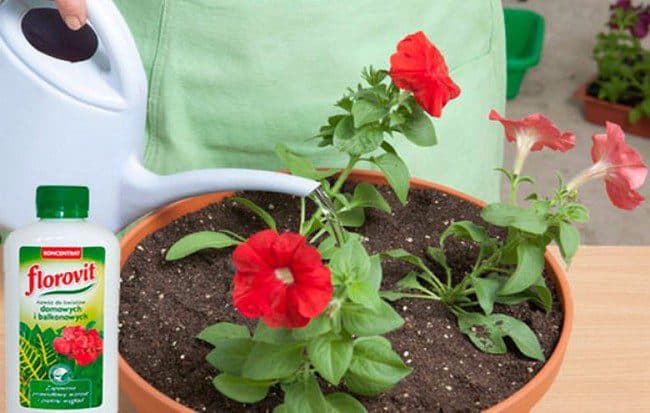
Applying fertilizer is one of the most mandatory activities, since petunia, like all nightshade crops, needs a large amount of nutrients.Even if you immediately make rich, nutritious soil, you still cannot do without fertilizing in the future. For plants grown in pots, boxes and flowerpots, this is especially important, since the volume of soil there is limited and is depleted faster than in flower beds.
Fertilizers are applied several times per season:
- the first time - two weeks after planting the seedlings;
- the second time - when mass tying of peduncles;
- in the future – every 10 days.
Petunia is fed with ready-made complex fertilizers for flowering plants. The main elements in them are potassium and phosphorus, which ensure lush and bright flowering. A small amount of nitrogen is also necessary to keep the bushes strong and healthy. However, it is important to maintain a balance here, otherwise plants overfed with nitrogen will only grow dense greenery and bloom little.
Petunias also need iron. Its deficiency is fraught with chlorosis, a disease in which the formation of chlorophyll in the leaves is disrupted. The greenery begins to turn yellow and fall off, the tops of the shoots dry out, and the roots gradually die off. To prevent this, petunia is fed 3-4 times a season with iron-containing preparations - “Ferovit” or iron chelate.
Attention! A reliable way to enhance petunia flowering is to spray the bushes with potassium monophosphate.
Useful for petunias and spraying with biostimulants, for example, Epin Extra. Such products support the vitality of the plant and help it withstand adverse natural factors. One foliar treatment per month is enough to keep the plant in good shape.
Any fertilizers are diluted according to the instructions and applied after watering so as not to burn the roots.It is better to do this in the evening - liquid that gets on the greens will leave burns under the influence of sunlight.
Formation
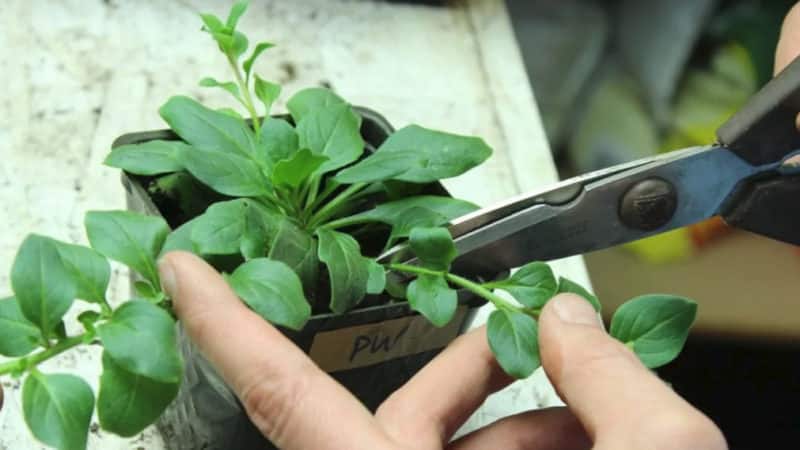
This procedure not only gives the bushes an aesthetic appearance, but also prolongs and improves flowering. For this purpose, cutting and pinching techniques are used. The first pruning is done at the seedling stage. At the stage of several leaves above 4-5 leaves, the tops of all plants are cut off with sharp, disinfected scissors. This will prevent the shoots from stretching and will be the key to the formation of a lush bush and abundant flowering in the future.
Pinching the top point serves as a signal for the plant to grow side shoots, which produce many more buds than without pinching. The flowers themselves grow larger and brighter and bloom longer.
Varieties of petunias are divided into bush, cascade and ampelous. In accordance with this, they are formed in different ways.
It is believed that three pinchings are enough for bush petunia. In practice, this is done as needed. This way you can form bushes of the desired shape and size. Hybrid petunia is easier to form than varietal petunia, since hybrids are initially predisposed to a spherical bush shape.
Important! Despite the fact that pinching and shaping stimulate and improve the formation of new buds, the procedure delays flowering by 1-2 weeks.
Ampelous and cascading varieties are climbing plants with long shoots. Usually they are planted in hanging flowerpots, from which the flowering vines hang and look very decorative. They are not formed in the form of lush bushes. But shoots that are too elongated look sloppy and bloom worse, so they are pinched out from time to time.
Is it possible to resume flowering if petunia has faded?
Petunia is an annual plant, so by the end of summer it quite naturally begins to fade. However, it is possible to extend its flowering period. To do this, use the so-called haircut. The shoots are cut by a third, leaving approximately 4-5 cm, watered and complex fertilizers for flowering plants are applied. After 1-2 weeks, new greenery will grow, buds will begin to form again, and the bushes will become “younger.”
This is interesting! Experienced flower growers who like to experiment, with the onset of cold weather, dig up petunia from the flowerbed and move it into the house. Despite the fact that the life cycle of the plant is limited to one season, in this way it can be slightly increased.
Advice from experienced flower growers
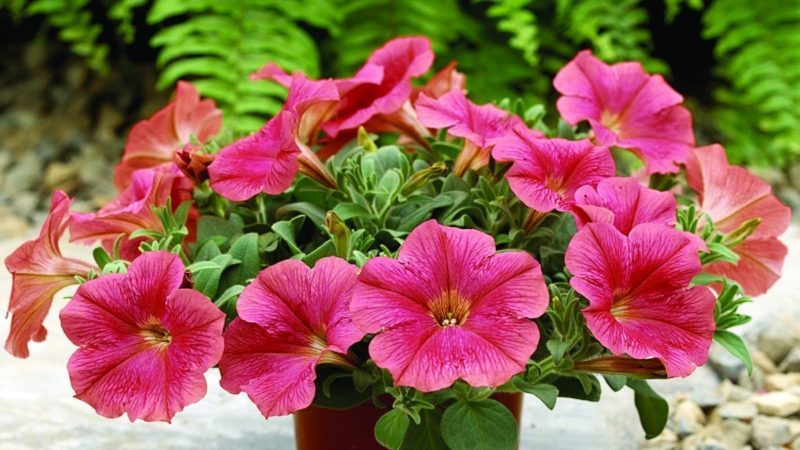
Attention and conscientious care are the main things that petunias need, like any flower. But there are some nuances that help to grow beautiful flowering plants. Experienced flower growers willingly share them:
- Petunia seedlings need acidic soil. For sowing and further cultivation, you can take special soil for cacti or simply acidify the existing soil mixture. You can add a little wood ash.
- When picking seedlings, it is better not to pinch the root; so as not to harm small seedlings. The petunia root system grows well without this technique.
- Pulling out shoots - a sure sign that the plants do not have enough light. Petunias need abundant lighting at all stages of development, therefore, when sowing seeds early (in February), the lack of sun is compensated for by illumination with fluorescent or LED lamps. This is especially true when the seedlings are placed on northern or eastern windows.
- It will not be possible to grow healthy and strong plants without hardening, especially in the northern regions. The sprouts are taken out into a cool room with a temperature of about +10°C, first for 15 minutes, then added every day for 5 minutes. Hardening strengthens the immunity of plants and prepares them for temperature changes.
- Petunia should not be planted densely at the seedling stage. Even if you pinch the seedlings correctly and in a timely manner, they will have little room to grow into lush bushes.
Conclusion
Petunia is good not only for its abundant flowering, but also because the lack of attention can be compensated for at any stage of its cultivation. If the plant is wilted, it is enough to resume regular watering, and it will quickly recover. Weak flowering is stimulated by fertilizing and pinching. If the life cycle of a bush comes to an end, it can be extended by rejuvenating it with a haircut and changing the flowerbed to home conditions.